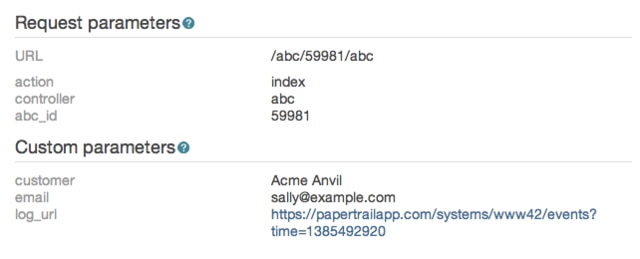-
Administrator Guide
-
Collect Logs
-
Collect Logs: Apps & Services
- ESXi
- Routers network hardware
- Apple iOS and macOS
- Unix and BSD system logs
- C# and .NET (NLog)
- C# and .NET (log4net)
- Java logback
- Android
- Kubernetes cluster logging with rKubelog
- haproxy
- Advanced Unix logging tips
- Perl
- Windows
- Kubernetes
- Erlang
- Node.js
- Java log4j
- JavaScript
- Unicorn
- PHP
- Docker
- systemd
- Ruby on Rails
- MySQL
- Unix and BSD text log files (remote_syslog2)
- Redis
- Go
- Python
- Elixir
- IIS
- Embedded devices or proprietary systems
-
Collect Logs: Hosting Services
-
Collect Logs: Integrations
-
Manage Logs
- Groups
- Log flood detection
- Web Hooks
- Log colorization
- Linking to logs
- JSON search syntax
- Settings API
- Log destinations
- Alerts
- Command-line client
- Log filtering
- HTTP API
- Automatic S3 archive export
- Managing Senders
- Permanent log archives
- Mapping senders to groups
- Search syntax
- Click-to-search
- Log search API
- Event Viewer
-
Send Logs for Analytics
-
SolarWinds Users & Orgs
-
Support and Security
-
What's New
New Relic traces
Introduction
New Relic transaction traces (and any service capable of accepting custom parameters) can show a link to related log messages in Papertrail.
To learn more about collecting custom parameters in New Relic, see custom parameters. This document is based on “Extending New Relic’s Custom Parameters.“
Result
The end result is a link from each transaction trace, like this:

How It Works
New Relic transaction traces measure the performance of a unit of work, typically a web request. Transaction traces can include arbitrary key/value attributes, which are shown alongside the trace.
With just a few lines of code in your app, we’ll generate a URL to Papertrail. The URL will include the system name and the current timestamp. Since Papertrail honors URL query parameters, Papertrail shows the logs which are very likely related to that transaction trace.
This URL is used as the transaction trace log_url custom parameter. No API integration is required other than the New Relic agent, which is already installed.
Setup
Language not listed? This technique applies to New Relic agents in all languages. For help, contact us.
Ruby
First, define a new Rails method to generate the URL and set the custom parameter. Edit app/controllers/application_controller.rb. Add this method in the existing ApplicationController class:
class ApplicationController < ActionController::Base
def add_papertrail_new_relic_custom_attribute
log_url = "https://papertrailapp.com/systems/#{Socket.gethostname}/events?time=#{Time.now.to_i}"
NewRelic::Agent.add_custom_attributes(:log_url => log_url)
true
end
endThe method calls add_custom_attributes, which is part of New Relic’s Ruby Agent (>= 3.12; older versions use add_custom_parameters). The method returns true because it is meant to be called as a controller callback.
Second, ensure that the new method is called during each request (or those which you would like to be linked). Add a before_filter to the top of the ApplicationController class definition, like this:
class ApplicationController < ActionController::Base
before_filter :add_papertrail_new_relic_custom_attribute
endDeploy this code change and restart your app. All subsequent transaction traces will include a link to Papertrail.
Java
First, define a new method to generate the URL and set the custom parameter. This can reside anywhere in your servlet or supporting libraries.
public class MyServlet extends HttpServlet {
private void addPapertrailNewRelicCustomParameter(HttpServletRequest req) {
String systemName = InetAddress.getLocalHost().getHostName();
long epochTime = Date.getTime() / 1000L;
String log_url = "https://papertrailapp.com/systems/" + systemName + "/events?time=" + Long.toString(epochTime);
NewRelic.addCustomParameter("log_url", log_url);
}
endNew Relic’s Java Agent API Example contains a simple servlet that shows how this works. In the example servlet, the saveNewRelicInfo method is equivalent to our addPapertrailNewRelicCustomParameter method.
The method calls addCustomParameter, which is part of New Relic’s Java Agent.
Second, ensure that the new method is called during each request (or those which you would like to be linked). This depends on your servlet structure, but typically means calling addPapertrailNewRelicCustomParameter from within your servlet’s processRequest method, similar to this:
protected void processRequest(HttpServletRequest req,
HttpServletResponse resp)
throws ServletException, IOException {
addPapertrailNewRelicCustomParameter(req);
doRequestWork(req);
writeResponse(resp);
}New Relic’s Java Agent API Example contains this method in context.
Deploy this code change and restart your app. All subsequent transaction traces will include a link to Papertrail.
The scripts are not supported under any SolarWinds support program or service. The scripts are provided AS IS without warranty of any kind. SolarWinds further disclaims all warranties including, without limitation, any implied warranties of merchantability or of fitness for a particular purpose. The risk arising out of the use or performance of the scripts and documentation stays with you. In no event shall SolarWinds or anyone else involved in the creation, production, or delivery of the scripts be liable for any damages whatsoever (including, without limitation, damages for loss of business profits, business interruption, loss of business information, or other pecuniary loss) arising out of the use of or inability to use the scripts or documentation.